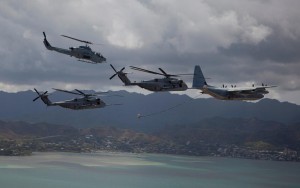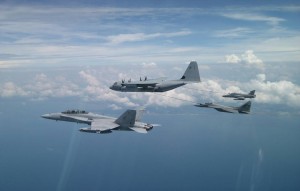2014-01-16 It took a while for the KC-130J to work out its wrinkles. But by 2002, the new plane entered into USMC operations.
This preceded the Osprey by five years, but the maturing of the Osprey and its pairing with the KC-130J is shaping a new long range force insertion capability.
According to Lt. General (retired) Trautman, former Deputy Commandant for USMC Aviation:
The KC-130J transition evolved as follows:
VMGR-252 (2nd MAW, East Coast) started their transition in 2002 and first deployed to combat in Jan 2005.
VMGR-352 (3d MAW, West Coast) was second to transition and they deployed in early 2006.
VMGR-152 (1st MAW, Westpac) transitioned in 2007.
The USMC plans to transition the first reserve squadron to KC-130J’s this year. This squadron is based in Dallas-Ft. Worth, TX.
Although not as advanced as the KC-130J, the Marines deployed KC-130F’s and R’s to Iraq and Afghanistan beginning in 2001 as well.
The impact of the pairing of aircraft can be seen in the emergence of new Special Purpose MAGTFs and in recent operations in the Philippines.
As one senior Marine has put it about the USMC engagement in the relief effort:
1st MAW had Ospreys and Hercs in Tacloban about 72 hrs after the storm passed. And I am not talking just about people on the ground but real, self-sustaining capability to move the mountains of relief supplies to where it was needed and where nothing else could get the job done so effectively.
There is no question it is a just a small effort against an immense catastrophe but the combination of rapid deployment and true capability is a crucial part of getting the response in play.
It is clear that the KC-130Js are key partners in operations with the Osprey, and the evolution of this partnership anticipates as well the coming of the F-35B to the MAGTF.
We had a chance to discuss the role of the KC-130Js in 1st Marine Aircraft Wing, with the CO of the Sumos, Lieutenant Colonel Jason “Julio” Julian, in early January 2014. Given his extensive involvement with the KC-130J throughout his career he provided significant insight into the first decade of the KC-130J and provided some thoughts about the way ahead for further innovation.
His experience with the plane started as follows:
Captain Julian was selected in December 2000 to serve in the newly formed KC-130J Integrated Test Team and was joined to VX-20 at Patuxtent River NAS, and later to VX-1 where he served as the Operations Officer of the KC-130J Operational Test Team.
SLD: You started with the test squadron but where do you stand today with flight hours on the aircraft? And how do you use the aircraft?
Lt. Col. Julian: In the J just over 4,000 hours. The plane is a central part of III MEF operations. The KC-130J is the only aircraft able to refuel jets, helicopters and tiltrotor aircraft and the tiltrotor works right there in the middle.
I have been here in Okinawa in command of VMGR-152 since May of 2012 and it is about the same exact time that we started getting the first of the Ospreys out here in Westpac. VMM-265 arrived in the summer of 2012, and we really focused all of our efforts on our ability to power project through strategic long-range tanking. It has been one of the core training evolutions that the squadron has focused on.

We conduct formation flights on as many of our missions as we can in order to prepare for long range tanking formations.
Our main mission here in the Pacific is enabling III MEF to operate anywhere in the theater through transport and aerial refueling.
SLD: How as the mission for the C-130s (and then KC-130Js) changed for the USMC in the Pacific over time?
Lt. Col. Julian: In the 1960s and 1970s, the primary mission of VMGR-152 was long range trans-Pacific refueling of jet aircraft. But the USAF does that mission now and KC-135s and KC-10s in particular are well suited for that mission.
And over the past decade we have evolved the tactical role of the KC-130Js as well with regard to support for the ground combat element. We conduct aerial delivery to the GCE, we can do rapid ground refueling for the GCE, we can do things like a low level insert, and other tactical support missions.
The context and capabilities have changed.
And we have been able to really become much more proficient in the wide range of assault support missions.
Although during Desert Storm the USMC operated entire squadrons of KC-130J’s on dirt strips and did some rapid ground refueling, it was not until OEF that we really had a chance to stretch our legs with the rest of our tactical missions.

In Afghanistan, and later in Iraq, we started doing lots of rapid ground refueling, lots of battlefield illumination, lots of aerial delivery, and we started becoming really proficient in wide variety of tactical support missions. And of course when we really took off on flying on night vision goggles, we became proficient at owning the night.
In many ways, the mission capabilities of the Marines KC-130J’s came closer to what the Air Force special Ops MC-130’s were doing. However, we are not conducting insertion of special operations troops and we don’t the ground mapping radar.
But we are refueling jets and helicopters. They cannot refuel jets, but we both refuel helicopters and tiltrotor aircraft and we are both doing aerial delivery, rapid ground refueling, landing on dirt strips at night. And our aircraft survivability equipment is quite robust so that we can go a lot of places that were too high risk before.
In other words, our capabilities have stretched and we have become much better at a broader range of assault support missions over the last decade.
SLD: What are the differences in refueling jets, helos and tiltrotor aircraft for the KC-130Js?
Lt. Col. Julian: Each operates at a different altitude and flight speed.
For example, the CH-53s are refueled typically at a flight speed of 105 and 115 knots and at altitudes ranging from 1000-5000 feet. The Ospreys are refueled at between 200 and 210 knots and at altitudes ranging from 5000 to 18,000 feet. And jets operate much higher at 25,000 feet and between 220 and 250 knots and it is easier to do so over the water because we can often fly over the weather with them.
And when weather gets bad, icing is a problem. The Osprey squadrons out here have worked hard on dealing with icing issues and have developed proficiencies in reducing the impact of icing problems.
The pairing between the KC-130Js and the Ospreys has brought an ability to shape organic modularity for long-range insertion of force in the region. We want to be able to provide for long-range vertical insertion throughout the region and to be able to deploy widely throughout the region as necessary. It is part of the operational dynamic and part of deterrence as well.
I would add that since the arrival of the Ospreys, about 2/3rds of our tanking requirement is to support the long-range assault support capability, which the Osprey provides.

We can now power project vertical lift anywhere in the region for the MAGTF faster than before.
SLD: What changes do you anticipate in the decade ahead for the KC-130Js and their role?
Lt. Col. Julian: As mission planning becomes integral to long-range assault missions, I can see an expanded role for systems onboard the KC-130Js in support of the mission.
And as the F-35Bs get added with their ISR and C2 capabilities, the KC-130J can be a logical place to house on the fly mission support structure as well.
And with the Harvest Hawk variant of the KC-130Js coming back from Afghanistan, their integration within the MAGTF can facilitate an enhanced role for the KC-130s within the tactical support mission as well.
In effect, the KC-130J is evolving in its tactical role into an expanded multi-function multi-mission aircraft.
Editor’s Note: In the video above, the next phase in the evolution of USMC aviation is highlighted as KC-130J refuels F-35Bs and Harriers.


